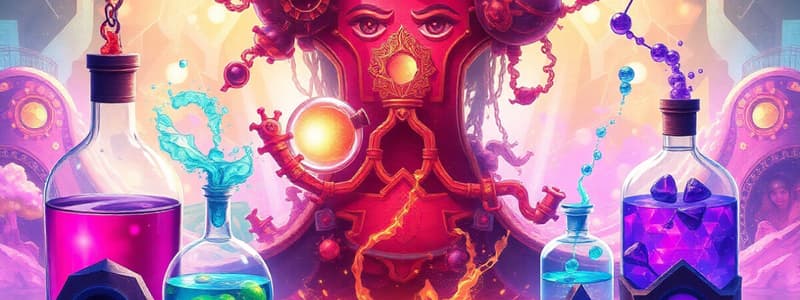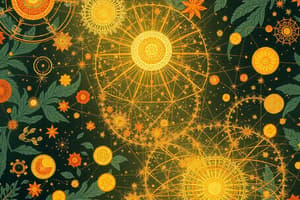Podcast
Questions and Answers
Which sub-atomic particle carries a positive charge?
Which sub-atomic particle carries a positive charge?
- Electron
- Proton (correct)
- Neutron
- Ion
A molecule is always a compound.
A molecule is always a compound.
False (B)
What type of ion has a negative charge?
What type of ion has a negative charge?
Anion
A homogeneous mixture is also known as a ______.
A homogeneous mixture is also known as a ______.
Match the following substances with their classification:
Match the following substances with their classification:
Which of the following is an example of a polyatomic element?
Which of the following is an example of a polyatomic element?
Identify the most accurate classification for stainless steel.
Identify the most accurate classification for stainless steel.
Consider a sealed container with only $N_2$ gas molecules. Would this be best classified as an element, compound, homogeneous mixture, or heterogeneous mixture? Explain your reasoning.
Consider a sealed container with only $N_2$ gas molecules. Would this be best classified as an element, compound, homogeneous mixture, or heterogeneous mixture? Explain your reasoning.
Flashcards
Atom
Atom
Basic unit of matter, made of protons, neutrons, and electrons.
Element
Element
A pure substance consisting of only one type of atom.
Ion
Ion
A charged atom or molecule due to the loss or gain of electrons.
Cation (+)
Cation (+)
Signup and view all the flashcards
Anion (-)
Anion (-)
Signup and view all the flashcards
Molecule
Molecule
Signup and view all the flashcards
Compound
Compound
Signup and view all the flashcards
Mixture
Mixture
Signup and view all the flashcards
Study Notes
- Matter occupies space, has mass, and possesses volume
- Density is mass divided by volume (d=m/v)
- Examples of matter: H2O(l), O2(g), CO2(g), C6H12O6(s), seawater, orange juice, Fe(s), Ag(s), He(g), N2(g), Hg(l), Br2(l), NaCl(s), air, stainless steel, blood, tomato, and books
Classification of Matter
- Matter is divided into pure substances and mixtures
- Pure substances have fixed chemical compositions and distinct properties
Elements
- Pure substances are divided into elements and compounds
- Elements consist of one kind of atom and can be monatomic or polyatomic (molecular)
- Examples of monatomic elements: He, Ar, Cu, Na, Fe, Mg
- Examples of molecular (polyatomic) elements: O2, O3, S8, P4, N2, F2
Compounds
- Compounds are composed of two or more different kinds of atoms (from different elements)
- Atoms are chemically bonded together in fixed proportions
- Simple compounds are either ionic or covalent (molecular)
- Examples of ionic compounds: NaCl, KNO3, (NH4)2SO4, CaBr2
- Examples of covalent (molecular) compounds: H2O, C12H22O11, NH3, CO2, CCl4, HCN
Mixtures
- Mixtures consist of two or more pure substances that retain their individual identities
- Mixtures have variable composition and are formed by a physical process, allowing components to be separated by physical methods
Types of Mixtures
- Mixtures are divided into homogeneous and heterogeneous mixtures
- Homogeneous mixtures have a uniform composition, also known as a solution
- An aqueous solution is a homogeneous mixture formed by dissolving a pure substance (solute) in water (solvent)
- Examples of homogeneous mixtures: brass (Cu + Zn), ink, bottled drinking water, air
- Heterogeneous mixtures have a non-uniform composition where parts are visibly distinguishable
- Examples of heterogeneous mixtures: sand and water, centrifuged blood
Physical States of Matter
- Includes solid, liquid, and gas
Properties of Solid State
- Fixed volume and shape, rigid, and least compressible
Properties of Liquid State
- Definite volume, no sepcific shape, and slightly compressible
Properties of Gaseous State
- No fixed volume or shape, assumes volume and shape of container, and most compressible
State Symbols
- Solid (s); liquid (l); gas (g)
Examples
- H2O(s), H2O(l), H2O(g)
Phase Changes
- Solid to liquid: melting/fusion
- Liquid to solid: freezing
- Solid to gas: sublimation
- Gas to solid: deposition
- Liquid to gas: vaporization/evaporation
- Gas to liquid: condensation
Studying That Suits You
Use AI to generate personalized quizzes and flashcards to suit your learning preferences.




